Why is Maghi Shri Ganesh Jayanti celebrated ?
Ganesh Jayanti is the day on which the frequencies of Deity Ganesh reached earth for the first time. Deity Shri Ganesh was born on this day. As per Hindu calendar, the tithi is Magh Shukla Chaturthi, that is the fourth day (chaturthi) of the bright fortnight of the Hindu lunar month of Magh. Hence, this day is also known as Maghi Shri Ganesh Jayanti. Let us understand what can we do on this day to obtain blessings of Deity Shri Ganesh.


Importance of Maghi Shri Ganesh Jayanti and Chaturthi
Significance of Maghi Shri Ganesh Jayanti is that the Deity principle of Shri Ganapati is 1000 times more active on this day than on other days. Deity Shri Ganesh was born on Chaturthi. On Chaturthi, the frequencies of Shri Ganapati and those of the earth match perfectly, and are most conducive to each other. Thus on Chaturthi, a greater proportion of Shri Ganapati waves can reach the earth. Worship of Shri Ganapati on the tithi of Chaturthi gives greater benefit of Shri Ganapati Principle.
How to celebrate Ganesh Jayanti ?
- Chant the name of Deity Shri Ganesh throughout the day.
- Pray to Deity Ganesh as many times as possible.
- Worship Deity Ganesh with utmost devotion and do Deity Ganesh arati.
- Offer red flowers and durva to Shri Ganesh.
- Recite Deity Ganesh stotras in the evening.
- Place the sattvik Chant-strip of Deity Shri Ganesh in the house.
Chant the name of Shri Ganesh !
To increase devotion and spiritual emotion and to benefit maximum from the increased Principle of a Deity, it is absolutely essential to chant the Name of the Deity appropriately. Let us listen to the below audio clip to understand the correct method of chanting the Name of Shri Ganesh.
On the auspicious occasion of Shri Ganesh Jayanti, the devotee or seeker should chant Deity Shri Ganesha’s name for 3 to 9 turns of a japa mala (of 108 stringed beads). The chant is ‘Om Gan Ganapataye Namaha |’.
Sanatan Sanstha has prepared Name-strips of Deities with sattvik fonts and border. If the font is sattvik, the words contain Chaitanya (Divine consciousness). The sattvik border is designed using symbols that match the Deity’s Principle. Example, here the border of Deity Ganapati’s chant-strip contains durva & hibiscus which are offered to the Deity. These chant-strips attract and emit the specific Deity’s Principle in a higher proportion. Placing the chant-strip in the house creates sattvikta (increase in positivity) in the house and also reminds us to chant the Deity’s name.
Recite the stotras of Deity Shri Ganesh !
There are two popular stotras of Deity Shri Ganesh. One of them is the Sankasht-nashan stotra, which was composed by Devarshi Narad. It includes 12 Names of Shri Ganesh. This stotra should be recited thrice a day in the morning, afternoon and at dusk, for fulfillment of all desires.
The other most common stotra of Shri Ganesh is the Ganapati Atharvashirsha. ‘tharva’ means toxic, ‘Atharva’ means peace. ‘shirsha’ means head. Atharvashirsha is the one who gives peace to the one who recites this stotra. This stotra was composed by Sage Ganak. In the Atharvashirsha first Shri Ganesh was praised and then meditated upon. Recitation of the Atharvashirsha overcomes all obstacles and liberates us from all sins. Also one acquires all the four pursuits of the soul – Dharma (Righteousness). Artha (wealth), Kama (desire fulfillment) and Moksha (Final Liberation).
Join our online satsang to learn more about festivals and spiritual practice !
On Shri Ganesh Jayanti, due to the increased principle of Deity Shri Ganesh in the atmosphere, many devotees get spiritual experiences. Join our online satsang to learn how to celebrate various festivals as per Dharmashastras, worshipping your favourite Deity and how to do spiritual practice for faster spiritual progress!
How to worship Deity Shri Ganesh on Maghi Shri Ganesh Jayanti?
Before starting the puja of Deity Shri Ganesh, do the following prayers.
A. O’ provider of intelligence, Shri Ganapati! Provide me with a virtuous intellect. O Vighnaharta (Vanquisher of all obstacles)! Remove all sufferings from my life!
B. O’ Shri Ganapati! You are the one who provides Pranashakti (Vital energy). Provide me with enough Shakti to work with enthusiasm throughout the day!
C. O’ Shri Ganapati! Through this worship, let devotion and bhav (Spiritual emotion) unto you develop in me!
D. O’ Shri Ganapati! By your grace, let me be able to imbibe maximum Chaitanya (Divine consciousness) from this puja (worship.
| Which finger should be used to apply Gandha? | Ring finger of the right hand |
| Which flowers are offered to Deity Shri Ganesh? | Red colored flowers |
| Incense-sticks of which fragrance should be offered? | Chandan (Sandalwood), Kevada (Screw-pine), Chameli (Jasmine) |
| How many incense-sticks should be offered? | Two |
| Which fragrance should be offered to Deity Shri Ganesh? | Heena |
| How many pradakshinas (circumambulations) should be performed around Deity Shri Ganesh? | Eight or in multiples of eight |
How to offer gandha, haldi and kumkum to Deity Ganesh?
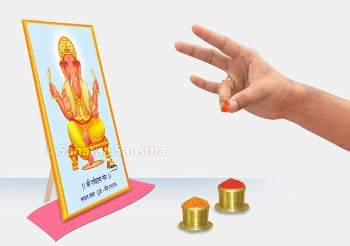
While performing Panchopachar puja, gandha (sandalwood paste) is applied to the Deity with the ring finger of the right hand. Thereafter, haldi (turmeric powder)-kumkum (Saffron) is offered at the Deity’s feet by taking a pinch of each between the thumb and ring finger of the right hand. Haldi is offered first followed by kumkum. The mudra formed by joining the tips of the ring finger and the thumb awakens the Anahat-chakra in the body of jiva and helps awaken the kriya-shakti (energy of action) in the jiva.
Which flowers should be offered to Deity Shri Ganesh?
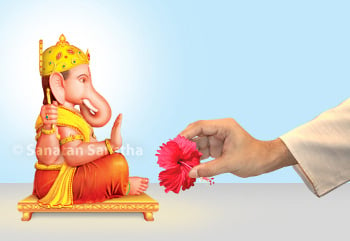
The complexion of Shri Ganapati is red. Red clothes, red flowers and raktachandan (Red sandalwood) are used in His puja (ritualistic worship). The red colour of these substances attracts pavitraks of Shri Ganapati from the atmosphere to the Idol in a greater proportion and helps in its awakening.
Picture depicting subtle characteristics of a red shoe-flower (hibiscus)
Why are durva offered to Deity Shri Ganesh?
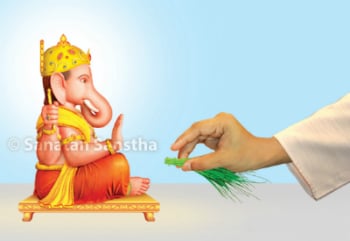
Durva, a sacred grass, has special significance in the puja (ritualistic worship) of Shri Ganapati. Durva has the maximum capacity to attract Shri Ganapati Principle, hence it is offered to Shri Ganapati. The durva to be offered to Shri Ganapati should be tender. It is referred to as ‘baltrunam’, that is young grass. The durva stalks offered should have leaves in odd numbers like 3, 5 or 7. The durva is tied together just like samidha. This preserves its fragrance for a longer period. To keep it fresh for a longer period, it is soaked in water and then offered. Both these factors contribute towards preserving the pavitrakas of Shri Ganapati in the Idol for a longer period.
Subtle Drawing depicting characteristics of Durva
Aarti should be sung after worshipping Deity Shri Ganesh. Sattvikta and bhav (spiritual emotion) in the Aarti depends upon the bhav of the individual singing it. The more the bhav of the individual singing the Aarti, the more the Aarti becomes enriched with bhav and sattvikta. Such an Aarti reaches the Deity faster. The sattva component and chaitanya generated by the words in the Aarti depend on the pronunciation, pace of pronunciation and pronouncing the words together or separately.
Sattvik Products related to Deity Shri Ganesh
SanatanShop.com
Know all about worshipping Deity Shri Ganesh…
This Audio Gallery is a collection of sattvik stotras, shlokas, artis and chants of Deities. This Audio Gallery contains Chaitanya-enriched audios recited in the sattvik voice of Saints and seekers who perform spiritual practice. Their recital is in a bhav-enriched voice with pure and appropriate pronunciation, pure language and in a scientific manner.









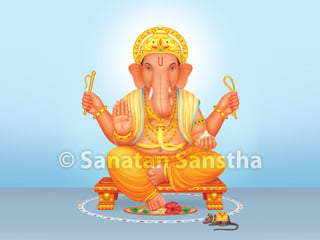 Sankashtnashan Stotra
Sankashtnashan Stotra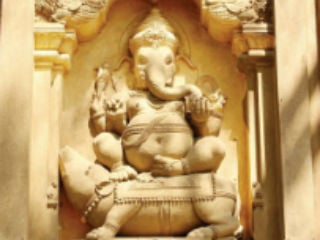 Signs of ancient Hindu culture left behind in foreign lands
Signs of ancient Hindu culture left behind in foreign lands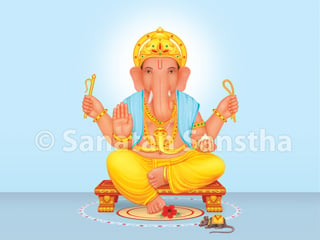 Some mantras to be recited when worshipping Shri Ganesh with specific objectives
Some mantras to be recited when worshipping Shri Ganesh with specific objectives Chants of Shri Ganesh
Chants of Shri Ganesh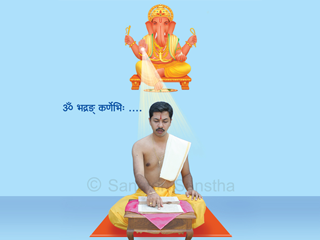 Shri Ganapati Atharvashirsham
Shri Ganapati Atharvashirsham